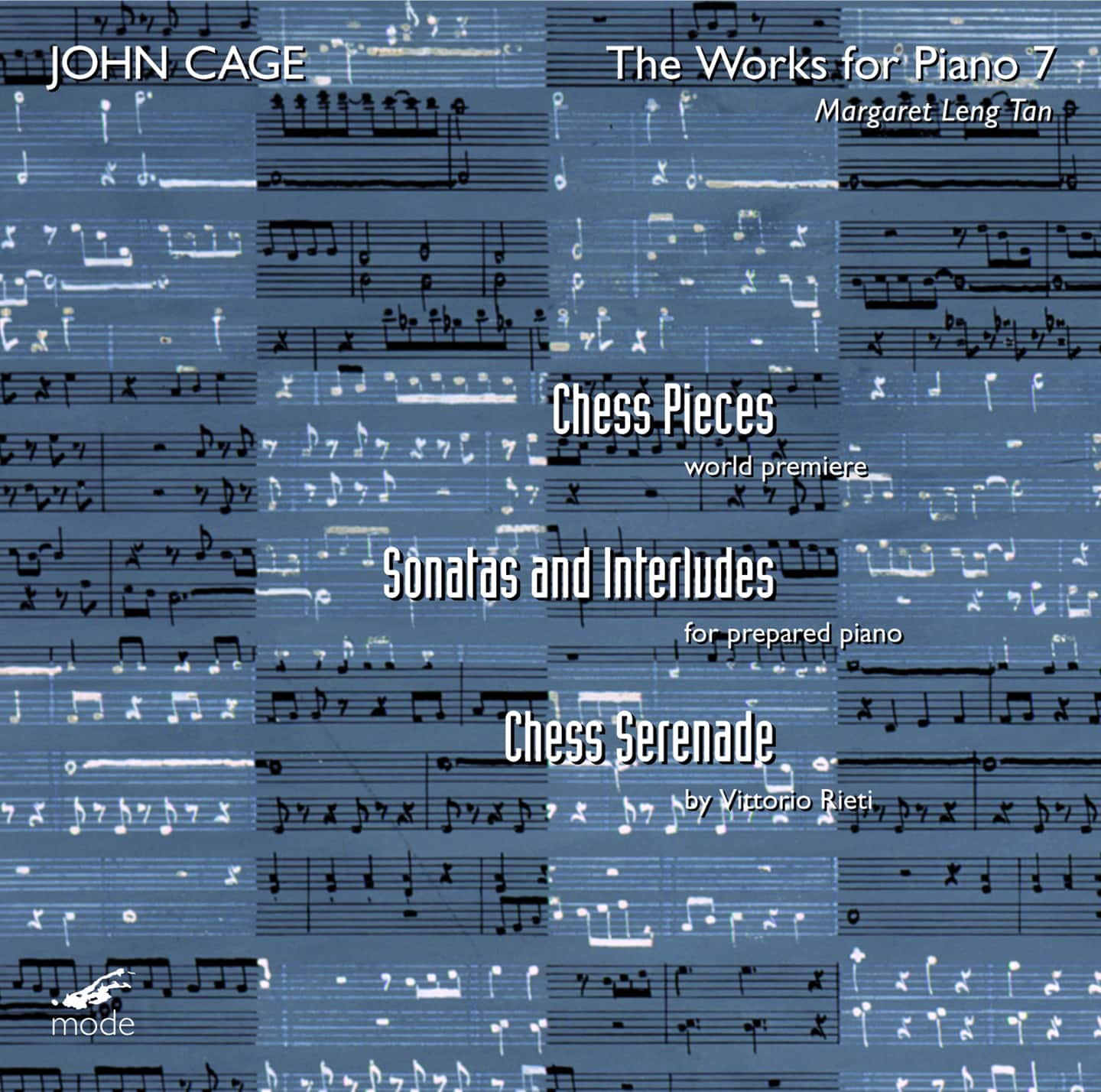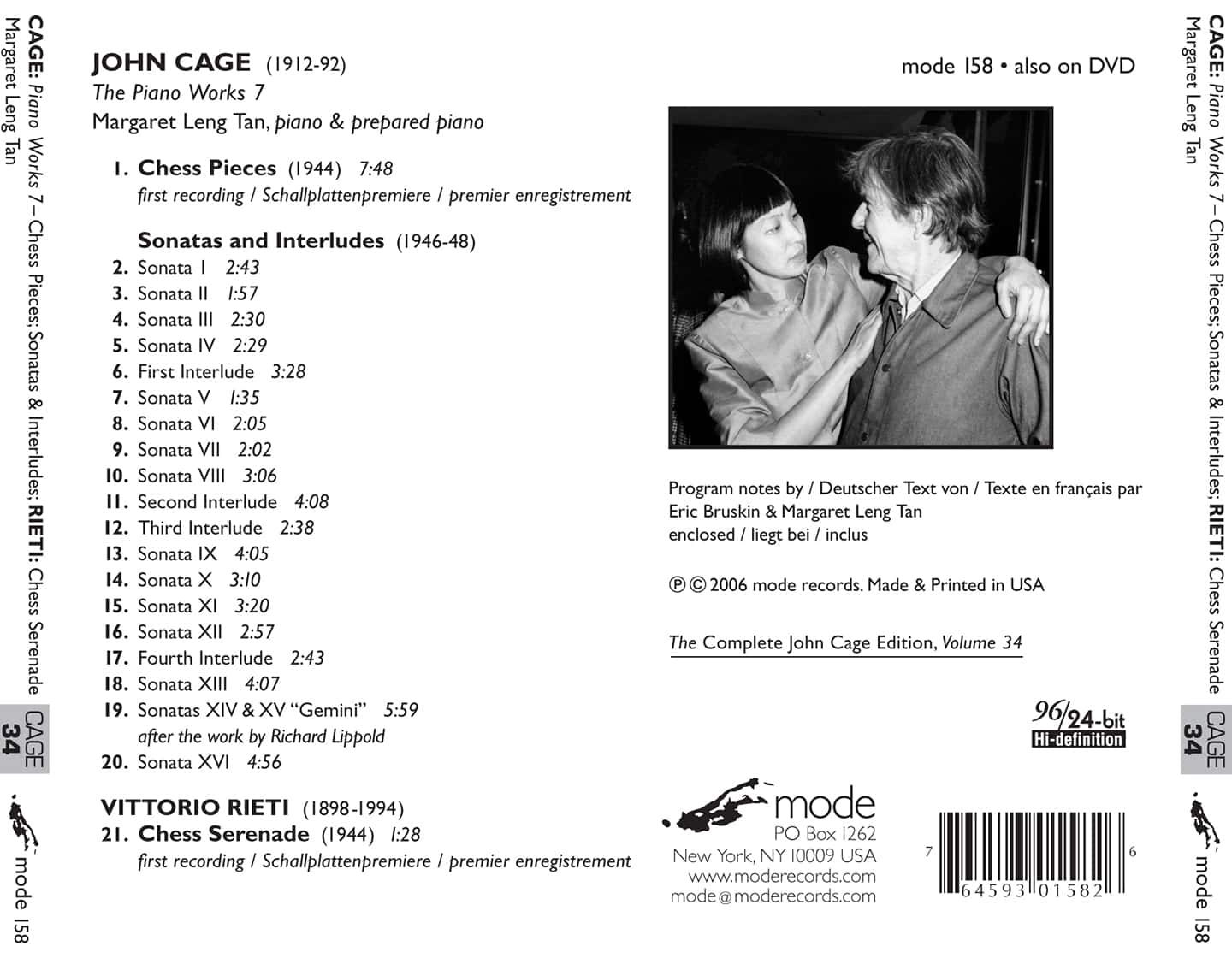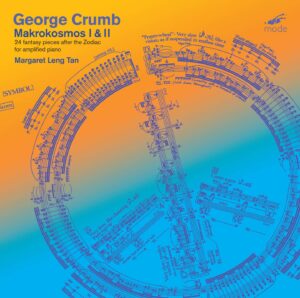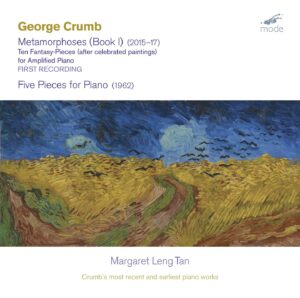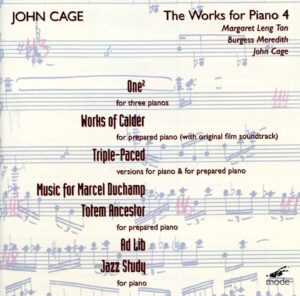Cage Edition 34–The Piano Works 7 - CD
(viewed Jun. 3, 2013). Previously released as a compact disc. (viewed Feb. 7, 2013). Margaret Leng Tan, piano, prepared piano. Recorded in 2005. Previously released as DVD. Electronic reproduction. Alexandria, VA : Alexander Street Press, 2012. (Classical music in video). Available via World Wide Web.
Margaret Leng Tan, piano & prepared piano
Chess Pieces (1944) (7:48)
first recording
Sonatas and Interludes (1946-48)
first recording
Sonata 1 (2:43)
Sonata II (1:57)
Sonata III (2:30)
Sonata IV (2:29)
First Interlude (3:28)
Sonata V (1:35)
Sonata VI (2:05)
Sonata VII (2:02)
Sonata VIII (3:06)
Second Interlude (4:08)
Third Interlude (2:38)
Sonata IX (4:05)
Sonata X (3:10)
Sonata XI (3:20)
Sonata XII (2:57)
Fourth Interlude (2:43)
Sonata XIII (4:07)
Sonatas XIV & XV “Gemini” (5:59)
after the work by Richard Lippold
Sonata XVI (4:56)
VITTORIO RIETI (1898-1994)
Chess Serenade (1944) (1:28)
first recording
A major discovery and first recording of an important Cage piece from 1944.
In 1944, John Cage was invited to participate in “The Imagery of Chess” exhibition at the Julien Levy Gallery in New York City. The artists included Calder, Noguchi, Motherwell, Breton, Duchamp, Ernst, Man Ray, Tanning and other leading surrealists.
Cage contributed a painting entitled “Chess Pieces”. It was purchased at the show and went into a private collection. For decades it was deemed lost and was (almost) forgotten by Cage afficionados and scholars.
Re-assembling the original artworks for “The Imagery of Chess Revisited” show (2005-06) at the Isamu Noguchi Museum in New York led to the tracking down of the Cage painting.
Cage expert Margaret Leng Tan set about transcribing the music in the painting into a playable score which receives its premiere recording here.
Chess Pieces is from 1944, an emotional and creative year for Cage; besides echoes of Satie, Chess Pieces contains prophetic touches of minimalism and has features in common with his monumental piano piece, Four Walls, from the same year.
A renowned Cage interpreter, Ms. Tan worked closely with the composer from 1981 to 1992. Cage was particularly appreciative of her performances of his works for the prepared piano. This is Ms. Tan’s long-awaited recording of Cage’s prepared piano masterpiece, the Sonatas and Interludes of 1946-48.
Also included is the first recording of the only other musical score from “The Imagery of Chess” show, neo-classical composer Vittorio Rieti’s Chess Serenade.
Also available as a surround sound DVD (MOD-DV158) with full performance videos of Chess Pieces and Chess Serenade, plus 2 documentaries: Mr. Cage’s Prepared Piano (Ms. Tan takes an in-depth look at the prepared piano), and CAGE: Music/Art/Chess (a closeup look at Cage’s and Rieti’s pieces in the Noguchi Museum’s “The Imagery of Chess Revisited” show).
Only on DVD
ADDITIONAL DOCUMENTARY VIDEOS:
Mr. Cage’s Prepared Piano: an insightful look at the history of the prepared piano narrated and performed by Ms. Tan, who also demonstrates how to (and not to) prepare a piano, and describes the preparations in detail both visually and sonically. She prepares and performs excerpts from Bacchanale, Cage’s first prepared piano work, and Sonatas & Interludes.
Cage and the Art of Chess: a visit to “The Imagery of Chess Revisited” exhibit at the Isamu Noguchi Museum with curator Larry List and Ms. Tan. Together they describe Cage’s relationship to the show and examine the “Chess Pieces” painting in detail – they also discuss Rieti and his Chess Serenade. Mr. List explores a separate feature on Cage’s wife, Xenia Cage, and her Chess Table (Xenia was an artist and also had a piece in the show) and sheds additional background on her life and work.
24-bit surround sound DTS and Dolby Digital surround.
Dedicated 24-bit stereo mix.
English, French, German and Spanish subtitles.
NOTE: Sonatas & Interludes is not accompanied by video.
Language : English.
Reviews
John Cage
The Piano Works 7
Cage Chess Pieces. Sonatas and Interludes. Rieti Chess Serenade.
Margaret Leng Tan
Mode 158
Cage composed his seminal collection for prepared piano, Sonatas and Interludes, between 1946 and 1948, a time when he was investigating Hindu philosophy but before he adopted aleatory as his guiding creative principle. Sonatas and Interludes is, therefore, a scrupulous notated score, both in terms of the notes and chords that constitute its mellifluous flow, and the positioning of every nut, screw, pencil and eraser that creates its unique blend of timbres. Yet although Cage left nothing – as it were – to chance in this score, and room still exists for interpretative choices, Margaret Leng Tan’s new recording will come as a real surprise, especially to those who think they know the work. Prepare to be startled by the very opening chords, with the use of the soft or una corda pedal: it is quite unlike any other recording of this music I have heard. Tan’s pedalling – specifically notated in the score – gives her version a unique sonic image, quite different to other celebrated modern accounts, say, by Joanna MacGregor (SoundCircus), Aleck Karis (Bridge) or – my favourite prior to this newcomer – Boris Berman (Naxos).
In Tan’s hands, the musical perspective in Cage’s music suddenly acquires an extra dimension or layer of colour that one does not hear in rival accounts. True, the warmer, fuller sound may mask, relatively speaking, some of the drier textures one is used to, but these differences are akin to those between the Javanese and Balinese gamelan orchestras whose sound world Sonatas and Interludes so magically evokes. However, this is a revelatory account for its musical qualities as well as the timbral, as cursory listenings to, say, Sonata V, the central pair of Interludes or the conjoined pair of Gemini Sonatas (XIV and XV) which have real but understated majesty.
The disc boasts further novelties in the recovery of Cage’s Chess Pieces, transcribed by Tan (who writes about the work in the booklet) for piano from a painting Cage exhibited in The Imagery of Chess exhibition in New York in 1944-5. At almost 8 minutes duration this delightful piece is a significant addition to Cage’s oeuvre and indeed to American piano music of the 20th century. It is paired with the briefer and blander Chess Serenade composed for the same exhibition by Vittorio Rieti.
— Guy Rickards, International Piano, September/October 2006
John Cage
The Piano Works 7
Margaret Leng Tan (piano)
Mode 158
John Cage
A Cage of Saxophones 2
Ulrich Krieger & Other Artists
Mode 160
The view that another recording of Sonatas and Interludes for Prepared Piano (now 60 years old) is the last thing anyone needs right now ignores the vividness and precision of the version, performed by Margaret Leng Tan. The opening will turn heads: a peal of chimes that contrasts sharply with even the approved versions by Maro Ajemian and others. As Eric J Bruskin points out in his liner notes, it’s extraordinary that no one before Tan seems to have read the score closely enough to use the prescribed damper pedal for those famous chords. Cage, of course, laid down some of his preparations very exactly and others with apparent indifference. There’s a myth that he prescribed the sound of the Sonatas and Interludes very exactly. In fact, every performance differs, but this one seems more different than most and, for the moment at least, definitive. There’s an extra dimension in the chirping of a cricket at intervals.
The other bonus of this set is the rediscovery of Chess Pieces, a score abstracted from a Cage painting included in the Imagery of Chess exhibition in New York in 1944 (the score went on public view last October for the first time). The piece is a Satie-esque lightweight, 22 little modules of 12 bars, conventionally read. The other amuse-bouche is Vittorio Rieti’s Chess Serenade from the same show.
Performed by Ulrich Krieger, A Cage of Saxophones 2 deals with late works, going right back to the beginnings with the Sonata for Two Voices from 1933 (done here on soprano and tenor), Composition for Three Voices from the following year for soprano, accordion and cello, and Solo with Obbligato Accompaniment of Two Voices in Canon played on alto, B flat clarinet and cor anglais. Clarinettist Erich Wagner and double reed specialist Birgit Schmieder guest on the last piece; elsewhere Krieger is joined by Tobias Ruger and Reimar Volker, all three of them playing sopranos on a superb excerpt from Atlas Eclipticalis. The highlight of the set is Krieger’s baritone solo derived from the orchestral parts of the 1957-58 Concert For Piano and Orchestra, one of Cage’s most important pieces of the period.
Episodic these recordings may be, but they help fill in more and more of the Cage canon and underline its inexhaustibility. The early works also act as a useful reminder of how much his language and procedures derived from the Second Viennese School.
— Brian Morton, The Wire, July 2, 2006
John Cage
The Piano Works 7
Margaret Leng Tan (piano)
Mode 158
The late John Cage was arguably the most important and influential thinker of 20th century art, yet his music is so esoteric that few people truly appreciate of it. In his later years there were so many random factors in his scores that it seemed to become more or a “happening” rather than listening material; even Cage saw some of those later works as Zen-like experiments of “purposeful purposelessness.”
That was rectified when pianist Margaret Leng Tan began to work with Cage in his last years. While other interpreters seemed to see Cage’s music as stoic and austere, Tan always approached his music the same way Gould approached Bach, or Horowitz approached Rachmaninov; as music. The humanity and breath of each piece rings under her touch.
Tan gives great performances of the classic “Sonata and Interludes (for Prepared Piano)” and the newly discovered “Chess Pieces,” which she edited. But more importantly, the DVD version of this disc (a CD audio-only version is also available) offers three short documentaries where Tan talks about the prepared piano, the editing of “Chess Pieces,” and one where she goes through the preparation materials that came with the published score of “Sonatas and Interludes.”
The prepared piano was one of Cage’s major concepts; nuts and bolts and pieces of felt, rubber, and plastic were inserted into the strings to give the piano a percussive sound, like that of a gamelan orchestra. Tan goes through the history of the prepared piano, presents a “how-to” instruction video, and raises aesthetic questions about the preparation that I never thought of, such as exactly where on the strings are the foreign objects placed in the piano harp?
“Chess Pieces” offers some of her best detective work; the score was originally in a painting that has been in a private collection for over half a century, and was not catalogued as a part of Cage’s works because it was thought to be incomplete. Through comparing it to the existing fragments of notes, Tan edited the “painting” into a beautiful piece of music.
While Cage’s music is not for everyone, this DVD makes his concepts more assessable than any album liner notes I’ve ever read. I would not hesitate recommending this disc for even the borderline or casual fans of Cage and/or 20lh century music.
— Wilhelm Murg, NONzine, June 9, 2006
John Cage
The Piano Works 7
Margaret Leng Tan, piano
Mode 158 (CD)
Performance: 
Sound: 
The seventh volume of John Cage’s piano works — or Volume 34 of the Complete John Cage Edition, if you prefer — features a transcendent performance of the Sonatas and Interludes for Prepared Piano (1948) meticulously rendered by avant-garde keyboardist extraordinaire, Margaret Leng Tan. Yet Volume 2 in this series features a 1994 recording of the same work, played by Philipp Vandre. For those aiming to collect the full series, this may be an annoyance, but others catching these CDs as they are released will surely appreciate having Tan’s superb interpretation of the Sonatas and Interludes, with premiere recordings of Cage’s long-lost Chess Pieces for piano (1944) and Vittorio Rieti’s Chess Serenade (1944) as bonuses, rather than search for the older disc of the single work. But despite seeming redundant, this CD is clearly one to get: Tan is simply remarkable in the Sonatas and Interludes, giving a realization that is scrupulous in execution, deep in sonic dimensions, and luminous in color; and she offers what is actually a “period performance,” since she plays a piano identical in its specifications to the small Steinway Cage originally prepared in the process of composition. The differences in sonorities between this album and others are immediately noticeable, especially in this recording’s superior resonance and crystalline details; anyone who already knows this work will recognize that Tan’s interpretation is truly Cagean in its poetic nuances and hypnotic power. So without disparaging other recordings for being less authoritative — certainly, Tan holds a considerable advantage for having worked closely with Cage in his final years — it is safe to say that fans of his most popular piano work will give this album full marks. Mode’s sound quality is ideal, too, so this CD receives the highest recommendation.
— Blair Sanderson, allmusic.com, March 2006

